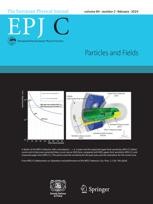The first black hole image: A gravitomagnetic monopole as an alternative explanation
The Event Horizon Telescope made science history when it captured the first image of the supermassive black hole in the galaxy M87. New research suggests alternative explanations for the massive compact object at the centre of this galaxy questioning if this could contain gravitomagnetic monopole.
New York | Heidelberg, 12 November 2021
 The Event Horizon Telescope (EHT) has recently mapped the central compact object of the galaxy M87 with an unprecedented angular resolution. Though the remarkable breakthrough has been interpreted based on theory that M87 contains a rotating or “Kerr” black hole. New research published in EPJ C by Chandrachur Chakraborty and Qingjuan Yu at the Kavli Institute for Astronomy and Astrophysics, Peking University (KIAA-PKU), Masoumeh Ghasemi-Nodehi and Youjun Lu, at the National Astronomical Observatories of China, looks at possible alternative explanations for the image.
The Event Horizon Telescope (EHT) has recently mapped the central compact object of the galaxy M87 with an unprecedented angular resolution. Though the remarkable breakthrough has been interpreted based on theory that M87 contains a rotating or “Kerr” black hole. New research published in EPJ C by Chandrachur Chakraborty and Qingjuan Yu at the Kavli Institute for Astronomy and Astrophysics, Peking University (KIAA-PKU), Masoumeh Ghasemi-Nodehi and Youjun Lu, at the National Astronomical Observatories of China, looks at possible alternative explanations for the image.
“The EHT collaboration has tried to show that the observed image is overall consistent with the expectations for the shadow of a Kerr black hole,” Chakraborty says. “As the alternatives to the Kerr BH have not been ruled out, we have investigated whether the EHT data is also consistent or not with alternative models for the central object of M87.”
Chakraborty goes on to explain that he and his co-authors had one primary purpose to show how a gravitomagnetic monopole — or an NUT parameter — affects the shadow size and shape, and whether its existence can be ruled out or not in M87*. “To show this, we use the observational parameter values of the first image of M87* and found that a non-zero gravitomagnetic monopole is still compatible with the current EHT observations,” Chakraborty says.
Chakraborty goes on to explain what a gravitomagnetic monopole is: “In nature, north and south magnetic poles always go hand in hand. Cutting a bar magnet in half just creates two magnets, each of which still has two poles, rather than creating separate north and south poles on each half. Yet their electrostatic cousins, positive and negative charges, exist independently.”
The researcher adds that in theoretical physics, gravity and electromagnetism have analogous features. “Mass is considered as the analogous to electric charge. Therefore, we call mass the gravitoelectric charge,” Chakraborty says. “The next question is does gravitomagnetic charge or the so-called gravitomagnetic monopole exist in nature?”
In the paper the authors propose that M87* may contain a gravitomagnetic monopole, and, therefore, could be described as a more general Kerr-Taub-NUT spacetime, with Kerr spacetime a special case of the Kerr-Taub-NUT spacetime with vanishing gravitomagnetic monopole.
“In that sense, no models are incorrect, and this basically put a strong constraint on the spacetime structure of the central compact radio source in M87.” Chakraborty concludes, adding how competing theories could be tested. “Essentially, accurate measurements of both the shadow size and asymmetry could put strong constraints on Kerr parameter and NUT parameter, and break the degeneracies between the Kerr and Kerr-Taub-NUT spacetimes, including those between the black holes and naked singularities.”
References: Ghasemi-Nodehi, M., Chakraborty, C., Yu, Q. et al. (2021), Investigating the existence of gravitomagnetic monopole in M87*. Eur. Phys. J. C 81, 939 (2021). https://doi.org/10.1140/epjc/s10052-021-09696-3
Further Information
For more information visit: www.epj.org
Services for Journalists
The full-text article is available open access here.
Contact
Sabine Lehr | Springer | Physics Editorial Department
tel +49-6221-487-8336 | sabine.lehr@springer.com
